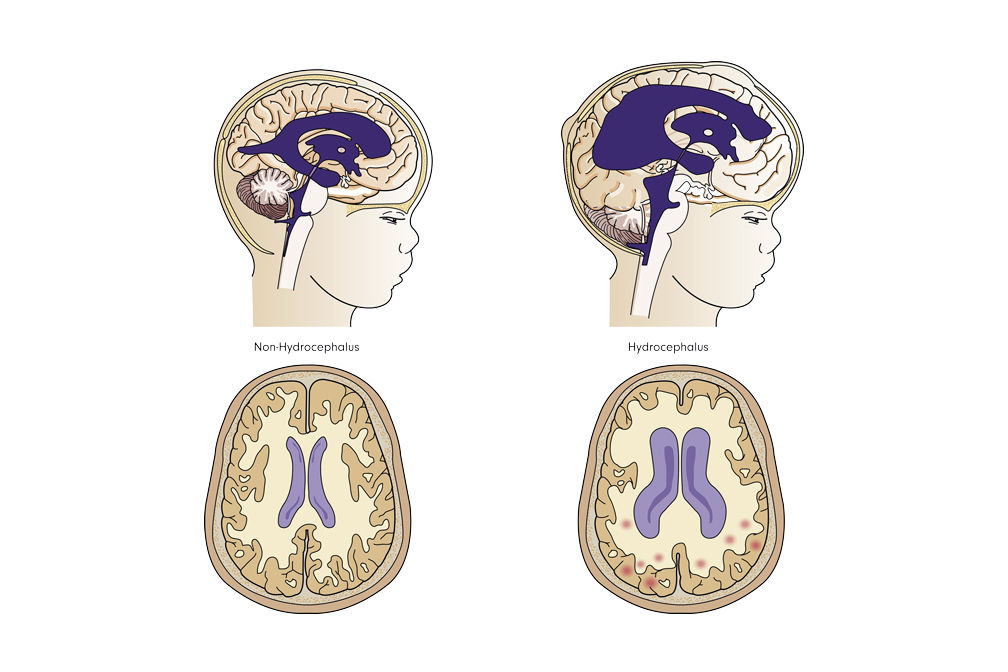استسقاء الدماغ وباللاتينية هيدروكيفالس تعني تجمع الماء بالدماغ. والمعنى الأصح هو ازدياد تجمع السائل الشوكي الدماغي داخل التجاويف البطينية الدماغية مما يؤدي الى ازدياد ضغط حجرة الدماغ والتسبب بأذى انسجة الدماغ طبيعيا.
يوجد بالدماغ تجاويف بطينيه دماغيه أربعه وبينها ممرات ضيقه، ويفرز السائل الشوكي الدماغي من داخل التجاويف البطينية بمعدل نصف لتر يومياً، ويمر هذا السائل الشفاف من داخل التجاويف البطينية عبر الممرات الضيقة الى محيط الدماغ والحبل الشوكي لكي يشكل مخدة وواقي صدمه حولهما، وبعدها يُمتص هذا السائل بنفس سرعة افرازه الى الدورة الدموية مما يعطي اتزان وثبات لحجم السائل وضغطه داخل الدماغ، ومن وظائف السائل أيضاً توزيع المواد المغذية للدماغ وعند حدوث انسداد بتلك الممرات الموجودة بين تلك البطنيات الأربعة، يتجمع السائل الشوكي الدماغي داخل التجاويف مما يؤدي الى اتساعها وازدياد الضغط على الأنسجة الدماغية وايذائها. ويسمى هذا النوع من الاستسقاء استسقاءً انسداداي (Obstructive Hydrocephalus).
وعادة ما يكون الانسداد بالقناة الواصلة بين التجويف البطيني الثالث والرابع. ويحدث هذا النوع من الاستسقاء عند حديثي الولادة نتيجة اضطراب خلقي بالممرات المذكورة أو انسداد القناة عند حدوث ورم أو نزف أو اصابه بمنطقتها أدت الى انسداد تلك الممرات وتحدث بكافة الأعمار الأخرى.
وعند حدوث اضطراب بسرعة امتصاص السائل الشوكي الدماغي بالأوعية الدموية نتيجة حدوث التهاب السحايا أو التهاب الدماغ أو حدوث نزف، بحيث يكون نسبة امتصاص السائل الشوكي الدماغي للأوعية الدموية أقل بكثير من نسبة افراز السائل فيحدث تجمع السائل الشوكي الدماغي بكل التجاويف البطينية الأربعة مما يؤدي الى اتساعها وارتفاع الضغط الدماغي بداخلها. ويسمى هذا النوع الاستسقاء الاتصالي.
أعراض الاستسقاء الدماغي
أن الأعراض عند الأجنة قد تشاهد من خلال التصوير الصوتي للجنين في رحم والدته وذلك بازدياد حجم الرأس وتوسع التجاويف البطينية الدماغية، وقد يصاحب الاستسقاء الدماغي الخلقي عيوب خلقيه أخرى مثل القيلة العصبية بالحبل الشوكي.
وعند الولادة يكون حجم الرأس كبيراً بالنسبة للوجه ويزداد حجم الرأس بنسبة كبيره لا تتناسب مع نمو المولود الطبيعي وعند البالغين، فإن الأعراض تكون نتيجة ازدياد الضغط الدماغي ومنها: الصداع، والاستفراغ، واضطراب البصر، واضطراب الاتزان، واضطراب الذاكرة والتركيز، وقد يؤدي الى الموت في حال عدم المعالجة. وتصل نسبة حدوث الاستسقاء الدماغي الخلقي الى واحده من كل خمسمائة ولادة ومعظمها يشخص قبل الولادة أو أثناء الولادة أو بعدها
تشخيص الاستسقاء الدماغي
يمكن تشخيص الاستسقاء الدماغي لدى الأجنة بمنتصف العمر الجنيني من خلال التصوير للرحم. وبعد الولادة يمكن التشخيص الدقيق بعد أخذ السيرة المرضية، والفحص السريري، والتصوير الطبقي المحوري للدماغ أو التصوير بالمرنان المغناطيسي للدماغ
علاج الاستسقاء الدماغي
أن العلاج التقليدي للاستسقاء الدماغي هو جراحي بواسطة زراعة تحويله للسائل الشوكي الدماغي من الدماغ للبطن ( Ventriculoperitoneal Shunt: V-P Shunt )
نقوم بإجراء هذه العملية باستخدام التخدير العام. ومن خلال فتحه صغيره بالجمجمة ندخل انبوبه بقطر 2 ملم الى داخل التجويف البطينين الجانبي الدماغي المتسع ونوصله بصمام خاص يزرع تحت فروة الرأس وموصول أيضاً بأنبوبه رفيعة تحت جلد الرقبة والصدر ومتجه الى البطن حيث ينتهي هناك حول الأمعاء والمعدة. وبهذه الطريقة يقوم الجهاز المزروع بتصريف السائل الزائد فقط من الرأس الى البطن لامتصاصه هناك. وطبعاً يكون الجهاز تحت الجلد وتحت فروة الرأس وغير مرئي ولا يحس به المريض ويكون الى الأبد

